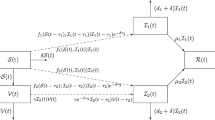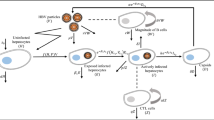Abstract
The cellular adaptive immune response to influenza has been analyzed through several recent mathematical models. In particular, Zarnitsyna et al. (Front Immunol 7:1–9, 2016) show how central memory CD8+ T cells reach a plateau after repeated infections, and analyze their role in the immune response to further challenges. In this paper, we further investigate the theoretical features of that model by extracting from the infection dynamics a discrete map that describes the build-up of memory cells. Furthermore, we show how the model by Zarnitsyna et al. (Front Immunol 7:1–9, 2016) can be viewed as a fast-scale approximation of a model allowing for recruitment of target epithelial cells. Finally, we analyze which components of the model are essential to understand the progressive build-up of immune memory. This is performed through the analysis of simplified versions of the model that include some components only of immune response. The analysis performed may also provide a theoretical framework for understanding the conditions under which two-dose vaccination strategies can be helpful.










Similar content being viewed by others
References
André J-B, Gandon S (2006) Vaccination, within-host dynamics, and virulence evolution. Evolution 60:13–23
Barbarossa MV, Röst G (2015) Immuno-epidemiology of a population structured by immune status: a mathematical study of waning immunity and immune system boosting. J Math Biol 71(6–7):1737–1770
Cao P, Yan AWC, Heffernan JM, Petrie S, Moss RG, Carolan LA, Guarnaccia TA, Kelso A, Barr IG, McVernon J, Laurie KL, McCaw JM (2015) Innate immunity and the inter-exposure interval determine the dynamics of secondary influenza virus infection and explain observed viral hierarchies. PLoS Comput Biol 11(8):1–28
Cao P, Wang Z, Yan AW, McVernon J, Xu J, Heffernan M, Kedzierska K, McCaw JM (2016) On the role of CD8+ T cells in determining recovery time from influenza virus infection. Front Immunol 7:611
de Graaf WF, Kretzschmar MEE, Teunis PFM, Diekmann O (2014) A two-phase within-host model for immune response and its application to serological profiles of pertussis. Epidemics 9:1–7
Diekmann O, de Graaf WF, Kretzschmar MEE, Teunis PFM (2018) Waning and boosting: on the dynamics of immune status. J Math Biol 77(6–7):2023–2048
Dobrovolny HM, Reddy MB, Kamal MA, Rayner CR, Beauchemin CAA (2013) Assessing mathematical models of influenza infections using features of the immune response. PLoS ONE 8(2):e57088
Gandolfi A, Pugliese A, Sinisgalli C (2015) Epidemic dynamics and host immune response: a nested approach. J Math Biol 70(3):399–435
Gilchrist MA, Sasaki A (2002) Modeling host-parasite coevolution. J Theor Biol 218:289–308
Hadjichrysanthou C, Cauët E, Lawrence E, Vegvari C, De Wolf F, Anderson RM (2016) Understanding the within-host dynamics of influenza A virus: from theory to clinical implications. J R Soc Interface 13(119):20160289
Hancioglu B, Swigon D, Clermont G (2007) dynamical model of human immune response to influenza A virus infection. J Theor Biol 246(1):70–86
Heffernan JM, Keeling MJ (2008) An in-host model of acute infection: measles as a case study. Theor Popul Biol 73(1):134–147
Iwasaki T, Nozima T (1977) Defense mechanisms against primary influenza virus infection in mice. I. The roles of interferon and neutralizing antibodies and thymus dependence of interferon and antibody production. J Immunol 118(1):256–263
Li Y, Handel A (2014) Modeling inoculum dose dependent patterns of acute virus infections. J Theor Biol 347(1):63–73
Li K, McCaw JM, Cao P (2021) Modelling within-host macrophage dynamics in influenza virus infection. J Theor Biol 508:110492
Moore JR, Ahmed H, McGuire D, Akondy R, Ahmed R, Antia R (2019) Dependence of CD8 T cell response upon antigen load during primary infection. Bull Math Biol 81(7):2553–2568
Moore JR, Ahmed H, Manicassamy B, Garcia-Sastre A, Handel A, Antia R (2020) Varying inoculum dose to assess the roles of the immune response and target cell depletion by the pathogen in control of acute viral infections. Bull Math Biol 82(3):1–14
Nowak MA, May R (2000) Virus dynamics: mathematical principles of immunology and virology. Oxford Univ. Press, Oxford
Pugliese A, Gandolfi A (2008) A simple model of pathogen-immune dynamics including specific and non-specific immunity. Math Biosci 214(1–2):73–80
Wu X, Wu P, Shen Y, Jiang X, Xu F (2018) Resident memory T cells and viral infection. Front Immunol 9:2093
Yan AWC, Cao P, Heffernan JM, McVernon J, Quinn KM, La Gruta NL, Laurie KL, McCaw JM (2016) Modelling cross-reactivity and memory in the cellular adaptive immune response to influenza infection in the host. J Theor Biol 413:34–49
Yan AWC, Zaloumis SG, Simpson JA, McCaw JM (2019) Sequential infection experiments for quantifying innate and adaptive immunity during influenza infection. PLOS Comput Biol 15(1):e1006568
Zarnitsyna VI, Handel A, McMaster SR, Hayward SL, Kohlmeier JE, Antia R (2016) Mathematical model reveals the role of memory CD8 T cell populations in recall responses to influenza. Front Immunol 7:1–9
Author information
Authors and Affiliations
Corresponding author
Additional information
Publisher's Note
Springer Nature remains neutral with regard to jurisdictional claims in published maps and institutional affiliations.
Rights and permissions
About this article
Cite this article
Pascucci, E., Pugliese, A. Modelling Immune Memory Development. Bull Math Biol 83, 118 (2021). https://doi.org/10.1007/s11538-021-00949-6
Received:
Accepted:
Published:
DOI: https://doi.org/10.1007/s11538-021-00949-6




